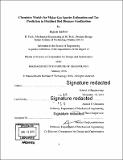Chemistry models for major gas species estimation and tar prediction in fluidized bed biomass gasification
Author(s)
Sridhar, Rajesh
DownloadFull printable version (17.90Mb)
Other Contributors
Massachusetts Institute of Technology. Computation for Design and Optimization Program.
Advisor
Ahmed F. Ghoniem.
Terms of use
Metadata
Show full item recordAbstract
The present work deals with the process of fluidized bed biomass gasification (FBBG), which is the thermochemical conversion of solid biomass into combustible synthetic gas using a fluidized bed. Fluidized bed gasifiers encounter high tar concentrations at the gasifier outlet necessitating expensive downstream cleaning equipment. Apart from the complex chemical pathways involved, tar production is also strongly dependent on the transport processes occurring inside the gasifier. Hence, the development of a detailed model to predict the variation of tar production under different operating conditions needs to include two important considerations: a comprehensive chemical kinetic sub-model and a detailed hydrodynamic sub-model. However, due to the huge computational expense associated with such a detailed simulation coupling the complex chemistry and hydrodynamics, there is a need to develop simplified models on both fronts. The first part of this work presents a detailed discussion on the chemistry models for biomass gasification: after introducing the existing state-of-the-art reaction mechanisms (both detailed and compact), two new global chemistry models, incorporating a global primary tar cracking reaction, for air-blown gasification and steam-blown gasification conditions are developed. The major gas species and total tar concentrations predicted using the global models in reactor network simulations of the gasifiers are compared with the corresponding predictions obtained using the detailed CRECK mechanism for biomass gasification, as well as with the available experimental observations. On the hydrodynamics front, an improved reactor network model based on the two-phase theory has been developed to better capture the mixing inhomogeneities in the bubbling fluidized bed, including mass transfer considerations between the bubble and emulsion phases. Finally, the predictions of various tar class concentrations and major gas species concentrations, obtained using the improved reactor network model in conjunction with the detailed CRECK kinetic reaction mechanism, for both air-blown gasification and steam gasification, are presented. Key words: Biomass gasification, Fluidized beds, Chemical reactor network modeling, chemical kinetics, chemistry mechanism reduction, Global chemistry model
Description
Thesis: S.M., Massachusetts Institute of Technology, Computation for Design and Optimization Program, 2016. Cataloged from PDF version of thesis. Includes bibliographical references (pages 133-140).
Date issued
2016Department
Massachusetts Institute of Technology. Computation for Design and Optimization ProgramPublisher
Massachusetts Institute of Technology
Keywords
Computation for Design and Optimization Program.